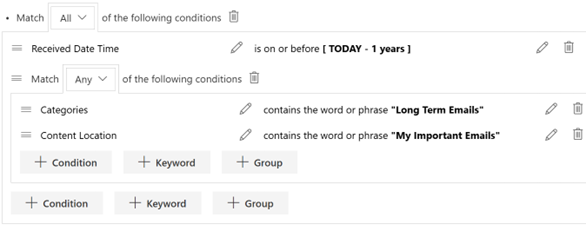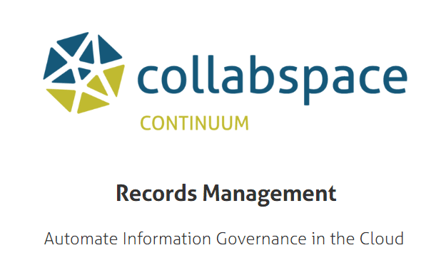My Experience Taking Collabware University Courses

Man takes webinar course on laptop. Image courtesy of Pexels.
This article documents my experience taking two Collabware University courses. Below I will cover:
- Why I Signed up for Collabware University
- What is Collabware University?
- What You’ll Learn, Course Overviews For:
- My Impressions of Collabware University
Why I Signed up for Collabware University
I recently had the opportunity to come aboard the Collabware team as a technical writer intern, and part of my job involves documenting the latest release notes and features of its cloud solution, Collabspace. As someone coming from a literature background, I would describe myself as more tech-adjacent than tech-savvy.
Two months ago from the time of writing, I had no prior experience working with the software or any detailed understanding of records management. Attempting to communicate the advantages and features of a platform without knowing a thing about it would seem counter-intuitive, but the Collabware Customer Success team was confident that taking a few Collabware University courses would get me up to speed.
What is Collabware University?
Collabware University is an online learning portal that was created to educate users on Collabware’s software products, empower them to take full advantage of its capabilities, and to help them to stay current on information governance best practices. Its breakdowns are aided by a glossary of terms and concepts, and it includes live demonstrations, examples of working practices and supplemental white papers.
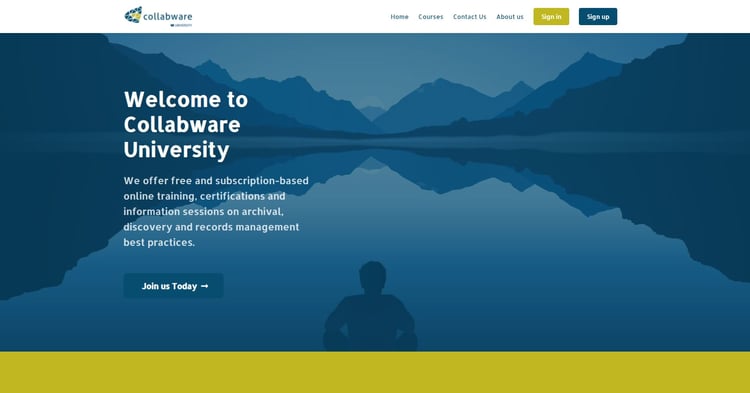
Collabware University homepage.
As I will cover in the next section, each piece of module content introduces a new concept and guides new users there. These module contents are digestible because they are presented concisely in manageable chunks. The Collabspace 101 course is about four hours in length, and users have the flexibility to progress through these modules at their own pace. For reference, between other tasks, I personally completed my courses over the course of one work week.
Course Overviews: What You’ll Learn
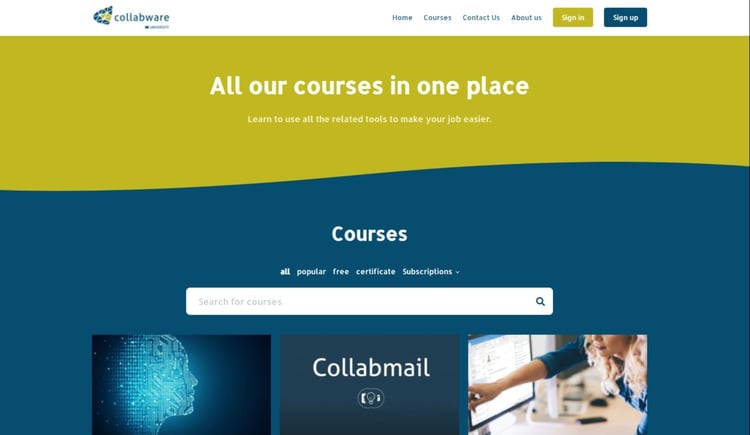 Collabware University Courses page.
Collabware University Courses page.
For my onboarding, I took the following two courses in Collabware University:
Artificial Intelligence and How it Applies to Records Management
With the sheer volume of data produced in an increasingly digitized workplace from multiple sources, being able to keep track of that for the purposes of records retention and minimizing the human hours needed for this process is an icebreaker to learning about Collabspace proper.
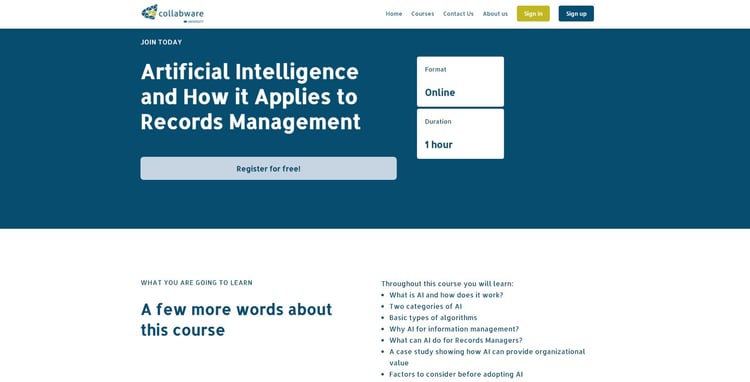
Collabware University 'Artificial Intelligence and How it Apples to Records Management' course page.
As an introduction to the software, the first course is based on a tech talk given by Collabware CEO, Graham Sibley. He explains the working applications of artificial intelligence algorithms and how they can be used in automated records management. Understanding Collabspace starts with understanding its design principles, and AI in this context is a lot less confounding than one might think.
For example, Collabspace's use of data streams drawn from multiple content sources pooled together is likened to a collective 'data lake'. This simple analogy provided a strong framework for me to understand what Collabspace does and how it does it. Being mindful of this foundation eased me into the learning modules of Collabspace 101.
Collabspace 101
Collabspace 101 is a structured course for learning the Collabspace cloud software set up and capabilities. Organized into focused areas of study, this course’s modules present video demonstrations that guide learners in real-time. It is supplemented with documentation, such as articles and white papers, to further inform understanding. Each module is followed by a short, multiple-choice quiz to check comprehension.
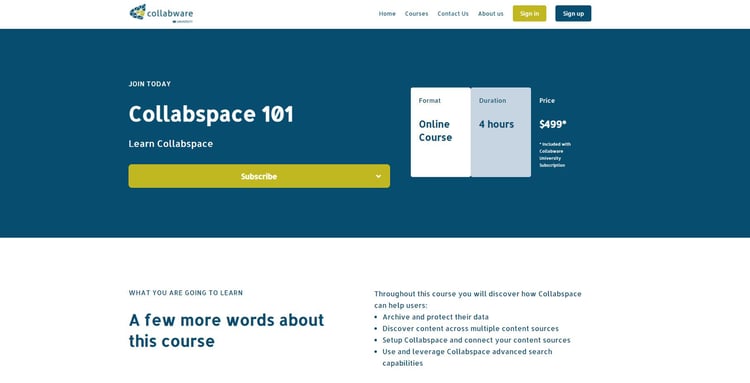
Collabware University Collabspace 101 course page.
Below is a summary of each module:
Understanding Collabspace
An introduction of how Collabspace serves as a records management tool, its design principles and its unique automation features and its design principles which serve to empower its users. There is a glossary of terms provided, which outlines key concepts behind what Collabspase does with organizational data, such as the Data Lake, WORM Storage, record retention schedules and archived versions of content. This all serves as an introduction and leads into the scope of what Collabspace can do in the context of data management.
Collabspace Setup and Security
How to add users to Collabspace, including deciding which users will securely access materials, grant permissions, and connecting users and content sources through Azure AD security groups.
Connecting to SharePoint Online
Outlines the step-by step process of establishing SharePoint Online site collections as source of content for Collabspace.
Connecting to Exchange Online
Establishing Exchange Online email inboxes as content sources for Collabspace.
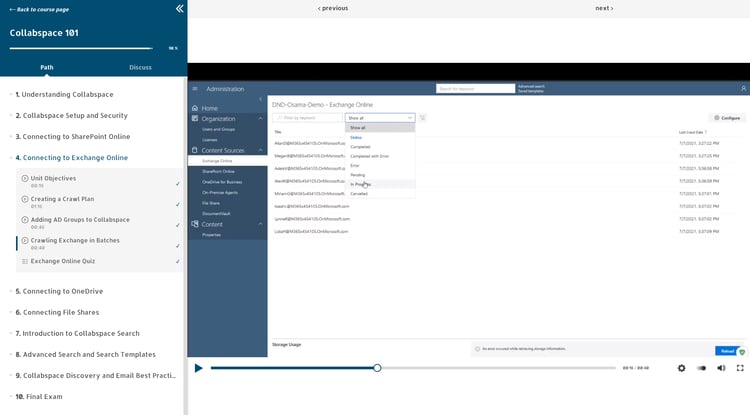 Demo for the Connecting to Exchange Online portion of Collabspace 101.
Demo for the Connecting to Exchange Online portion of Collabspace 101.
Connecting to OneDrive
Establishing OneDrive accounts as content sources for Collabspace.
Connecting to File Shares
Establishing File Shares as content sources for Collabspace. This module also includes a primer on how a file share works, explaining the relationship between servers, on-premise agents, adapters and the technical requirements needed to set them up.
Introduction to Collabspace Search
This module provides a working demonstration of some of the features of the Collabspace Discovery App. A walkthrough of search using Boolean search syntax operators, applying these for different indexed content sources, and the process of displaying and sorting these search results is outlined.
Advanced Search and Search Templates
This module expands on the basic search principles to create more specific and complex search queries. Additionally, users are taught how to modify user access permissions and how to share the search query as a template, which would be invaluable for consistency in reports, exporting the results to confirm record content status, and following up on previous inquiries.
Collabspace Discovery and Email Best Practices
This module emphasizes how to minimize organizational data loss by using Collabspace. Because company-internal emails are often overlooked as potential sources of critical data, the instruction outlines why they should be managed for business and record continuity. The demonstrations provide examples of scenarios in the workplace to consider and how Collabspace empowers a user to apply the principles learned in Search for filtering indexed emails, including reproducing archived versions of the original email files with fidelity.
Final Exam
Much like the quizzes that follow each learning module, there are 40 questions in multiple choice and true-or-false format which test your cumulative knowledge of the course teachings. Once you have finished this exam, you’ll have the option to collect a certificate to display your fluency with the software.
My Impressions of Collabware University
As part of Collabware's onboarding training, I had access to a Collabspace organization set up by my Azure Administrator as a series of sandbox training environments. Using workplace SharePoint and Exchange Online accounts as sources of indexed content, the video demonstrations of Collabspace 101 provided excellent examples to follow in each application. Each module informed me of the working context with the specific scenarios where they would be applied. I was able to follow along to gain a functional understanding of each application of the platform.
Thanks to Collabware University, I was able to gain enough understanding of the software features to apply them in practice and understand the context and scenarios so I am able to write about the platform moving forward.
The major value I found was learning functions of Collabspace Search modules, which provide a foundation of understanding how most of the platform works. It was rather intuitive for me, as it follows the Boolean syntax rules, and Advanced Search in particular took me back to my University days, searching through the databases for particular terms and articles. In fact, I was surprised to see how precise it was, as I'd created a dummy folder with some mock documents to find, and the Advanced Search worked so finely that I couldn't find it then and had to broaden my approach.
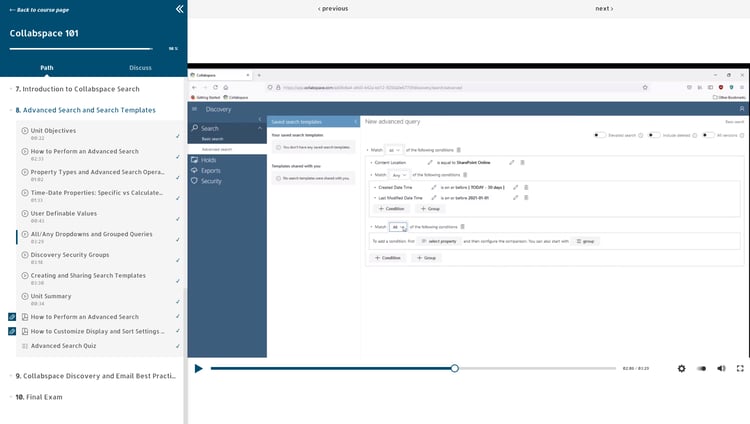 Demo of Advanced Search in Collabspace 101.
Demo of Advanced Search in Collabspace 101.
Because I was not involved in the setup process of my content sources, the process of connecting SharePoint, Exchange Online, OneDrive and File Shares eluded me. I was, however, able to follow along with the instruction, and by exploring the site collections I was able to find the necessary app to install Collabspace without a problem. A client with a vested interest in their Microsoft 365 apps who wants to make an effort to consolidate their content would easily be able to parse the logic. The File Share setup in particular had eluded my understanding at first. However, through the explanations of the instructor, I was able to gain a conceptual understanding of how a File Share works.
The breadth of Collabware University’s subject matter provides a starting point for any user to tap into the depth of potential within Collabspace. It expanded my knowledge base for writing about the software and has helped me better understand its latest features as the platform continues to expand and improve. With the support of the Collabware Help Centre, a wiki resource that every Collabspace user has access to, to supplement my learning, these courses were an effective walkthrough of how to get setup and use the different application functions.
In short, if somebody from a background of literature can learn how to use Collabspace after taking a Collabware University course, then so can you!
Would you like to learn about the latest in information governance best practices, or better understand the Collabware software products? Register for Collabware University today, or contact us if you have any questions!


